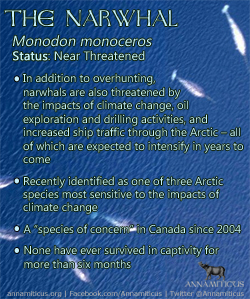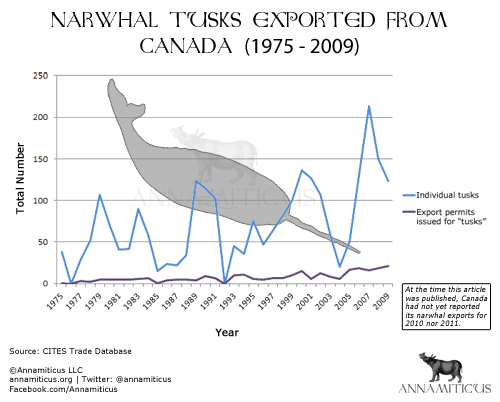
Although indigenous peoples in the Arctic have traditionally hunted narwhals for food, recent information suggests that the focus has shifted to the marine mammal’s tusk — which is actually nothing more than an elongated, uniquely-spiraled tooth.
The IUCN notes “substantial uncertainty about numbers and trends in large parts of the range and clear evidence of decline for specific subpopulations”, and explains that potentially unsustainable hunting may pose a very serious threat to their future.
The intense hunting (including associated loss due to wounding and sinking) in Greenland and Canada gives cause for concern, particularly given the lack of reliable data on hidden mortality and serious injury.
While narwhal hunting in Canada has been restricted to Inuit communities since 1971, the IUCN says that “the cash value of ivory and the need for cash to buy snowmobiles have both greatly increased”.
A 2005 report to the CITES Animal Committee says Canada exported an average of 79 tusks* per year between 1980 and 1985.
CITES trade data indicates that those figures have nearly doubled since then, with an average of 133 tusks exported each year between 2005 and 2009.
In fact, “tusks” comprised the majority of all narwhal exports Canada documented between 2000 and 2009.
Canada reported exporting total of 1,115 “tusks” during that time, mainly for commercial and personal purposes.
Modernized methods
Over the years, it seems “subsistence” narwhal hunters have started to abandon traditional practices for modern weaponry (which some argue are more “humane”).
 This shift has apparently improved killing efficiency and, in turn, enabled hunters to supply more narwhal ivory for international trade — yet it is still not considered a “commercialized” industry.
This shift has apparently improved killing efficiency and, in turn, enabled hunters to supply more narwhal ivory for international trade — yet it is still not considered a “commercialized” industry.
The IUCN noted that these observed changes are one of the most serious threats to these marine mammals.
Hunting with modern equipment in specific parts of Greenland and Canada represents the most long-standing and consistent threat to narwhals throughout their range.
Increased ivory trade
A 2005 report to the CITES Animal Committee says Canada exported an average of 79 tusks* per year between 1980 and 1985.
CITES trade data indicates that those figures have nearly doubled since then, with an average of 133 tusks exported each year between 2005 and 2009.
The majority of the 1,115 tusks exported from Canada between 2000 and 2009 went to Japan — primarily for “commercial purposes” — more than double the amount sent to any other country in the world during that time.
After Japan, China and Thailand ranked second and third (respectively) in top destinations for “tusks” exported to Asia from Canada between 2000 and 2009.
Trade ban
Perhaps fearing a global ban on narwhal ivory trade, the Canadian government finally issued a temporary ban on narwhal ivory exports from 17 of 22 narwhal-hunting Inuit communities in late 2010.
Indigenous peoples were reportedly outraged by the ban and argued that they were not consulted by the government before the decision was made, that their hunting activities are sustainable, and that the ban would have negative consequences for their livelihoods.
James Eetoolook — a representative of indigenous peoples’ rights group, Nunavut Tunngavik, Inc. (NTI) — told the Winnipeg Free Press earlier this month that “Inuit hunters kill about 700 narwhal a year and trade about 500 tusks”.
Although the ban has since been lifted in all but one community (most recently, it was dissolved in eleven of the communities last month), the situation could change in March 2013, when the CITES parties meet in Thailand.
Edited by Rhishja Cota-Larson
*Includes only the reported exports of whole tusks from each country and does not include other reported trade terms that include at least parts of tusks, such as “carvings” and “ivory pieces”.
Image: Glenn Williams (National Institute of Standards and Technology) via Wikimedia Commons
Additional sources:
Rodics, Katalin. “The Need for a New Review of Significant Trade in the Narwhal (Monodon monoceros).” Report prepared for the twenty-first meeting of the CITES Animals Committee, Geneva, Switzerland, 20-25 May 2005.
Whale and Dolphin Conservation Society. “The Review of Significant Trade in the Narwhal (Monodon monoceros).” Report prepared for the twentieth meeting of the CITES Animal Committee, Johannesburg, South Africa, 29 March-2 April 2004.





![Kopi Luwak off the Shelves as ‘Civet Farming’ Conditions Revealed [Photos]](https://annamiticus.com/wp-content/uploads/2013/11/Many-farms-that-keep-caged-civets-label-their-coffee-as-wild-sourced-150x150.jpg)